I knew it was a mistake, but I purchased the bitter melon anyway. It’s about the size of a young cucumber but with the skin of a 103-year-old man. It sat for several days before I worked up the courage to try the vine fruit that brags of bitter prowess in its name like a dare.
The bitter melon (or Momordica charantia), popular in some Asian cuisines, grows in South America and parts of Asia and Africa. And likely in hell.
I slice it lengthwise. Its fruit is light green and fuzzy, and I scrape away the yellowed seeds. I close my eyes and bite. Flavor profile: Tylenol tablet, if it were made with the texture of a watermelon. I’m certain I’ve eaten dirt that’s more appetizing.
I try to temper the bitter melon by grating it into a pool of hot melted ghee to sauté. I taste. Imagine powdered aspirin soaked in clarified butter.
Time for the big guns: a cup of organic cane sugar, a teaspoon of freshly ground cardamom, grated khoya (a mixture of high fat milk, milk powder, and more ghee—flavor profile: gritty parmesan cheese), and then a quarter cup of coconut milk. It is now softened and drowned in melted sugar and dairy and cardamom spice. I taste. Imagine Indian-spiced caramel dirt.
In the Asian market where I purchased the bitter melon, a woman told me to sauté it with onions, which seems like a perfectly good way to ruin onions.
The bitter melon is one of dozens of foods I try while exploring the extremes of the five flavors humans taste—sweet, sour, bitter, salty and umami. These flavors have been hardwired through evolution. We are satiated by foods that nourish us with calories (umami and sweet). We spurn those that are potentially harmful (sour and bitter).
But the extremes of flavor are also full of possibility, intrigue and desire, serving as the culinary equivalent of a train wreck. Our mouths simply can’t turn away.
Our tongues contain thousands of taste buds that have as many as a hundred taste cells with receptor molecules, each associated with one of those five flavors. The receptors send signals to our brains over specific, dedicated neural pathways. Each taste receptor acts independently. Each has its own genetic makeup. Each travels its own route. Each speaks to a different part of the brain cortex. In other words, our brains map flavors.
Those receptor cells also die repeatedly, once every couple of weeks, and we generate new ones. The new cells manage to find the right taste neurons by using signaling molecules called semaphorin, recreating the circuits anew.
We each have unique genetic predispositions to flavors. Some of us are less able to sense the intensity of sour. Some of us have a gene that lets us detect specific bitter compounds. As we age, our sensitivity to taste and smell can decrease. Some of us are what scientists call “supertasters,” with an ability to detect flavors more intensely than others. Taste sensitivity is also influenced by nutrition, hormonal changes, and medications.
Pity the poor chickens and cats whose sweet taste receptors do not work; or the panda, whose umami taste receptor left them during the animal’s evolution several million years ago.
Our olfactory senses also play a strong role in tasting experience, giving us the ability to detect what we think of as specific flavors but are really aromas. Bite an apple while holding your nose, and you’ll still taste the acidity of the fruit, but your brain won’t know whether you’re eating an apple or a pear.
We sense odors in the air both through the nose (orthonasal) and orally (retronasal) as we breathe. As with taste molecules, odor molecules are sent on neural pathways to the brain via the olfactory bulb.
Unlike taste, the neurological sensing of an aroma only has meaning in conjunction with prior experiences and associated emotions—like a caramel apple at Halloween or a tequila-fueled hangover. The olfactory sense does this by extending its use of the brain to the basolateral amygdala where qualitative assessments of sensory information takes place. (There is new scientific evidence that the amygdala also plays a role in preference and aversion for the five hardwired flavors in taste perception.)
In other words, sensory perception combined with associated experience gives meaning and memory to something as specific as cinnamon or the charred brussels sprout leaf.
Or bitter melon.
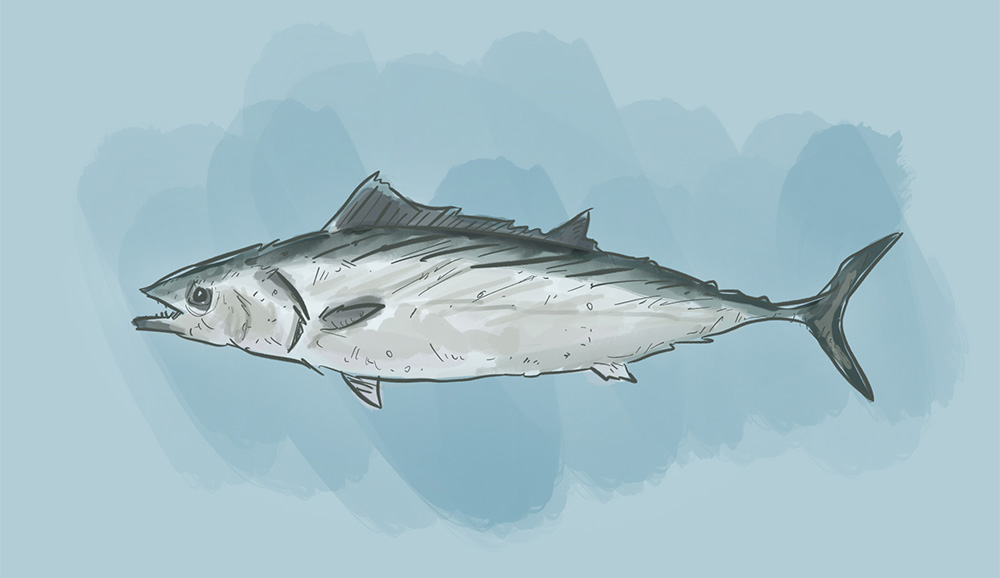
Umami
Dashi practically incubates umami. But to understand the depth of dashi—a fish stock used abundantly in Japanese cuisine—you first need to understand katsuobushi, one of its two main ingredients. Katsuobushi is made by artisans using bonito, a fish extremely rich in protein. The fish is cut, racked, simmered, scaled, deboned, smoked, molded and sun-dried in a tightly choreographed process that takes months.
Dashi combines katsuobushi with glutamate-rich kombu, a seaweed that also succumbs to lengthy drying processes. This combination is an umami Molotov cocktail.
Umami’s identification decades ago by Kikunae Ikeda, a scientist and professor at the University of Tokyo, was bolstered by neuroscientists who proved we possess independent umami taste receptor cells and neural pathways.
At its most basic, umami is the taste resulting from the breakdown of amino acids, in particular the salts of glutamate, inosinate, guanylate and ribonucleotides, according to the Umami Information Center. Yes, that’s a thing.
Umami is a signal to our brains that a food has protein, which is necessary for our survival. Foods like meat and fish spark our umami taste receptors, but tomatoes also contain glutamate, as do cheese and mushrooms.
Via aging or fermentation processes, umami can deliver exotic outcomes, like eggs cured in salt. Black garlic, made by applying just the right amount of slow heat to the amino acids and sugars of garlic manifests a piece of tangy, earthy, sticky delight.
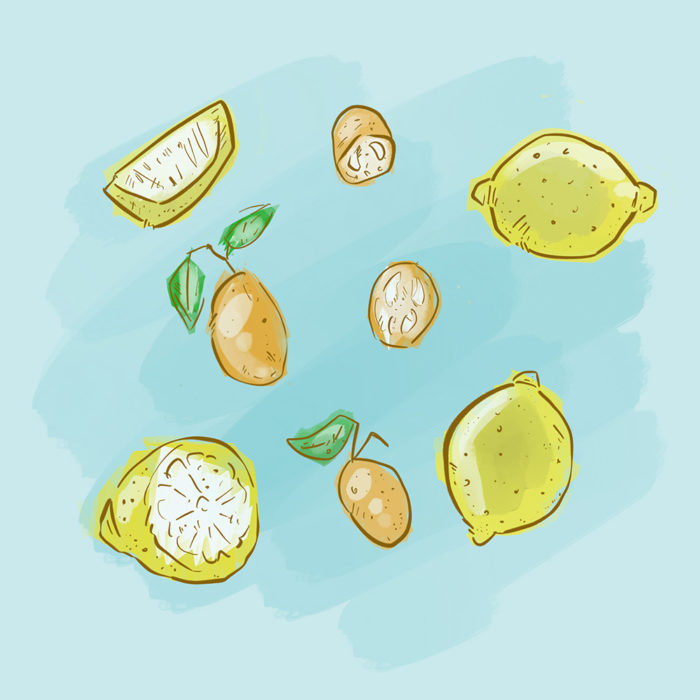
Sour
Only humans will seek, rather than avoid sour foods, scientists say. And even then, it’s a bit of a love-hate relationship.
Consider the ordinary kumquat. It looks like a miniature, oval-shaped orange. I like to think of it as nature’s version of the Sour Patch Kid. Instead of that candy’s sugar-granule coating, the kumquat’s thin, dimpled skin provides the fruit’s sweet surprise, a sensory retort to the typical citrus rind. It’s the sour fruit inside that makes your lips cinch and your tongue curl.
Our sour taste receptors respond to acidic foods, and serve as one of our sensory guides, along with sight and smell, to foods spoiled by bacteria or fermentation.
Acidity is measured on a pH scale. Lemons sit atop at a 2.0, on par with gastric acid and slightly above battery acid (1.0). Vinegar has a pH of 2.4, sauerkraut falls around 3.5, and my sneaky kumquats sit around 3.6.
Naturally, I candy the kumquats. I pierce them each several times with a toothpick. I boil the fruit in water and let it cool. I stew the kumquats again in simple syrup, boiling and cooling until the skins become translucent, like glowing orange bulbs. I drain the fruit overnight, and in the morning I roll it in cane sugar for a decorative flourish. Flavor profile: unripe orange gumdrop.
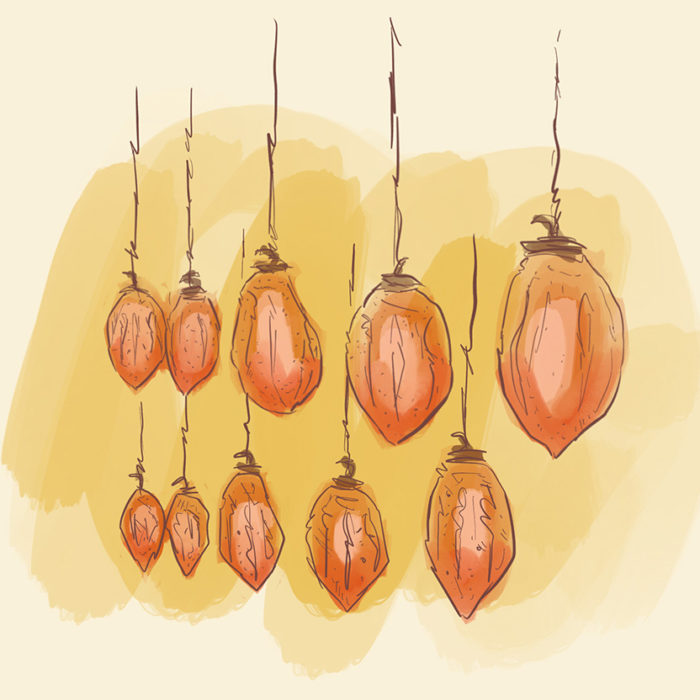
Sweet
During a trip to Taipei three years ago, I sat down for tea in The One, an ancient villa and resort in Xinpu township. Accompanying my tea was a piece of cold burgundy fruit that looked as if it had been rolled in fine sugar. Flavor profile: honeyed stone fruit sprinkled with cinnamon with a ginger chew texture. It was a dehydrated persimmon, and the sugars were natural—part of the fruit, the waiter told me.
What I enjoyed in Taipei is known as hoshigaki, a dried persimmon more common in Japan, and made using a time-consuming dehydrating process that requires hanging persimmons by a string, allowing them to dry outside (traditionally) or near a sun-drenched window, and applying a light hand-massage every other day for several weeks. That drying process, known as gluconic acid fermentation, along with the gentle massage, develops the texture by moving moisture out of the fruit and distributes the sugars to the outer part of the persimmon, creating a beautiful delicacy permanently etched in my basolateral amygdala.
I can’t stop thinking about it.
To fully understand our natural love affair with sweet, it’s telling that in test conditions rats will more frequently choose sweet water over cocaine or heroin. Our natural attraction to sweetness is driven by our need for calories to survive. Sugars, as detected by our sweet receptors, are an essential source of energy.
Common table sugar, composed of sucrose and other derivatives of sugar cane and sugar beats—such as powdered sugar, demerara and muscovado—are all the result of various levels of processing, some more natural than others. Honey, unless it is truly raw—taken directly from a bee hive—also usually undergoes some amount of processing, and is 1.5 times sweeter than table sugar.
Many additive, non-nutritive sweeteners are derived from natural sources. Stevia is extracted from the stevia rebaudiana plant and can be up to three hundred times as sweet as sucrose. Katemfe fruit, grown in the rain forests of west Africa and used to make Thaumatin extract, is two thousand times as sweet as table sugar.
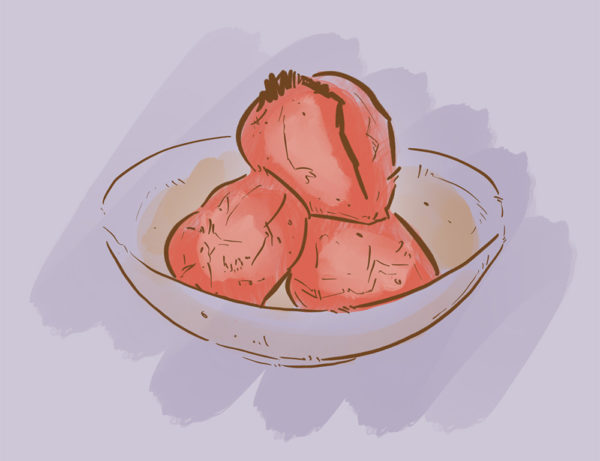
Salt
Don’t let the umeboshi fool you. Also known as a Japanese plum, technically it’s an apricot that has been pickled and dried. Although it is associated with Japan, many researchers believe its origins are in China. Whichever country created it turned a sour fruit into a mushy bite of salt.
I brace myself as I take in the umeboshi. It quickly pummels my taste buds. My lips tingle and my tongue feels like a slug in a salt storm. Curiously, I will crave another the following day.
Like sour, salt receptors respond to simple ions—in this case, sodium (in sour’s case, hydrogen). We seek salt because it is critical in helping maintain the proper balance of body fluids and electrolytes, and is instrumental for hydration and muscle function.
Too much salt brings sour and bitter taste cells into play, possibly as a way to guard against excessive salt, which can cause high blood pressure, which can lead to stroke, heart attacks, or renal failure.
Salt has also been used for millennia in food preservation. Curing, brining and pickling food, among many techniques, draws out moisture, which is a breeding ground for bad bacteria. When the bad bacteria storms away, good bacteria enters, creating a more acidic environment. Not only do these processes preserve foods, but they can enhance flavors.
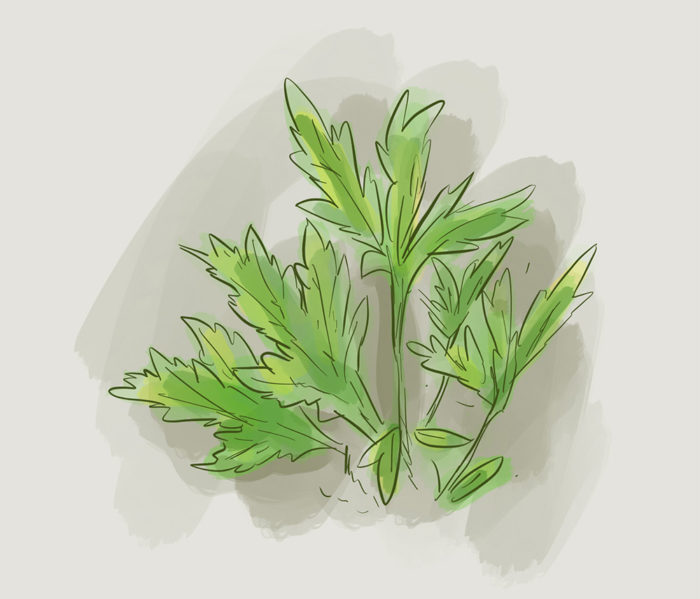
Bitter
Foraging in the Angeles Forest just outside of Los Angeles with Pascal Baudar, a Belgian who labels himself a culinary alchemist, we come across a number of non-native invasive plants that most of us would call weeds, but Baudar calls his terroir and uses as ingredients for wildcraft cuisine.
We stumble upon several bitter plants, including mugwort, and the one Baudar calls the most bitter plant in the universe: horehound. You may know it for its brow-furrowing presence in cough remedies. Beyond that, its uses are questionable, but it is edible. I give a leaf a bite and am left wondering for the next ten minutes if it’s possible to surgically remove my taste buds. It’s like eating grass dust.
Baudar uses horehound as a replacement for hops in making wildcraft beer. We make it right there in the forest, on a small propane stove on a picnic table.
We make a half gallon of beer, adding to water two handfuls of air-dried mugwort (aromatic, with a hint of pine), lemon halves, and two or three horehound leaves. Baudar tosses in wild turkey-tail mushroom and a sprig or two of California sagebrush. To this, he adds three-fourths cup of Piloncillo, an unrefined Mexican cane sugar. We boil this mixture and then cool it quickly to preserve the yeast and strain it back into the jug to ferment.
We try Baudar’s fully fermented and bottled beer made weeks before, the horehound neutralized as a natural bitter element, lingering as an aftertaste.
Scientists have speculated that our bitter flavor receptors have developed out of necessity, as a means of warding off toxic (poisonous) compounds that often make up bitter potential food items. And depending on how bitter a food is, our revulsion toward it scales. Some bitter compounds are known to have medicinal value, like our friend the horehound.
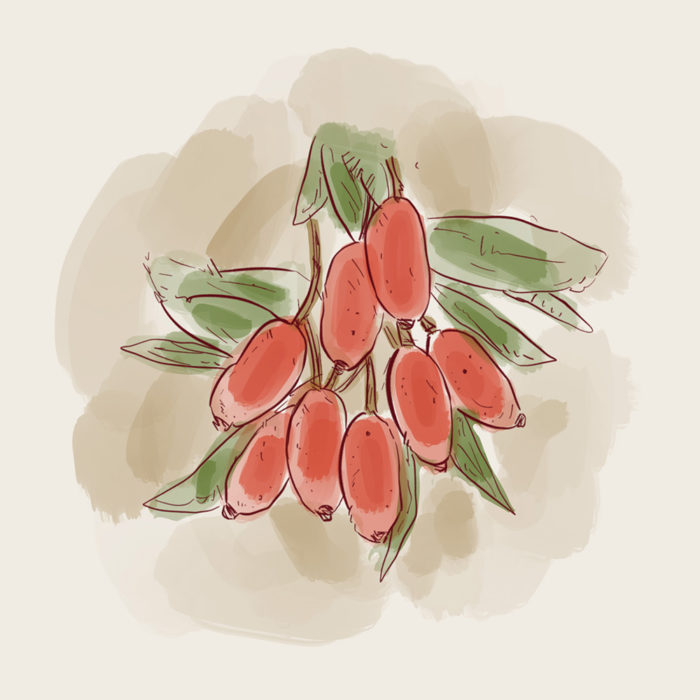
Flavor Miracles
Scientists can trick the neural pathways of flavor by shining tiny fiber-optic lights on the brains of laboratory rats, studying the resulting imagery using specialized two-photon microscopes. It’s how we know so much about how and why our senses work, and more importantly, it’s how researchers are working on treatments for everything from eating disorders and diabetes, to ALS and Alzheimer’s, to psychological diseases.
It’s time for a taste receptor-cell trick of my own, without the lasers and microscopes.
The so-called miracle fruit, or Richadella dulcifica, is a small red berry about the size, color and shape of a holly berry. It contains miraculin, a protein that attaches to sweet receptors. In neutral pH conditions, miraculin can lock out other sweeteners. It stops them from working. But in acidic conditions, the sweet taste receptors kick into high gear, turning sour and bitter foods sweet.
I bite into it with gentle force so as not to crush the pit. It’s not very sweet, but it’s syrupy. It feels like lidocaine, almost as if it is quietly stunning my taste buds. I spit out the seed, and I begin with a bit of a lemon. It tastes like lemonade. Better, my tongue seems like a magnet, pulling in the sugars and repelling the acids.
A sour tamarind might as well be a packaged sugary fruit rollup. I sip balsamic vinegar and it tastes like a cheap port. An early-season watermelon is delightful. A strawberry is like syrup. My kumquats aren’t tart.
You see where this is going . . .
Alas, my woebegotten bitter melon, my nemesis, that bitterest of bitter pills to swallow. We meet again, now on my turf, my berry to your bitter.
I do not frown, nor spit, nor regret. But as the neuroscientists of flavors and aromas would say, it is neither appetitive nor aversive. It tastes like nothing, although also like nothing good. I tolerate it, but still do not welcome it.
It is, if you’ll allow my pun, a bitter-sweet ending.





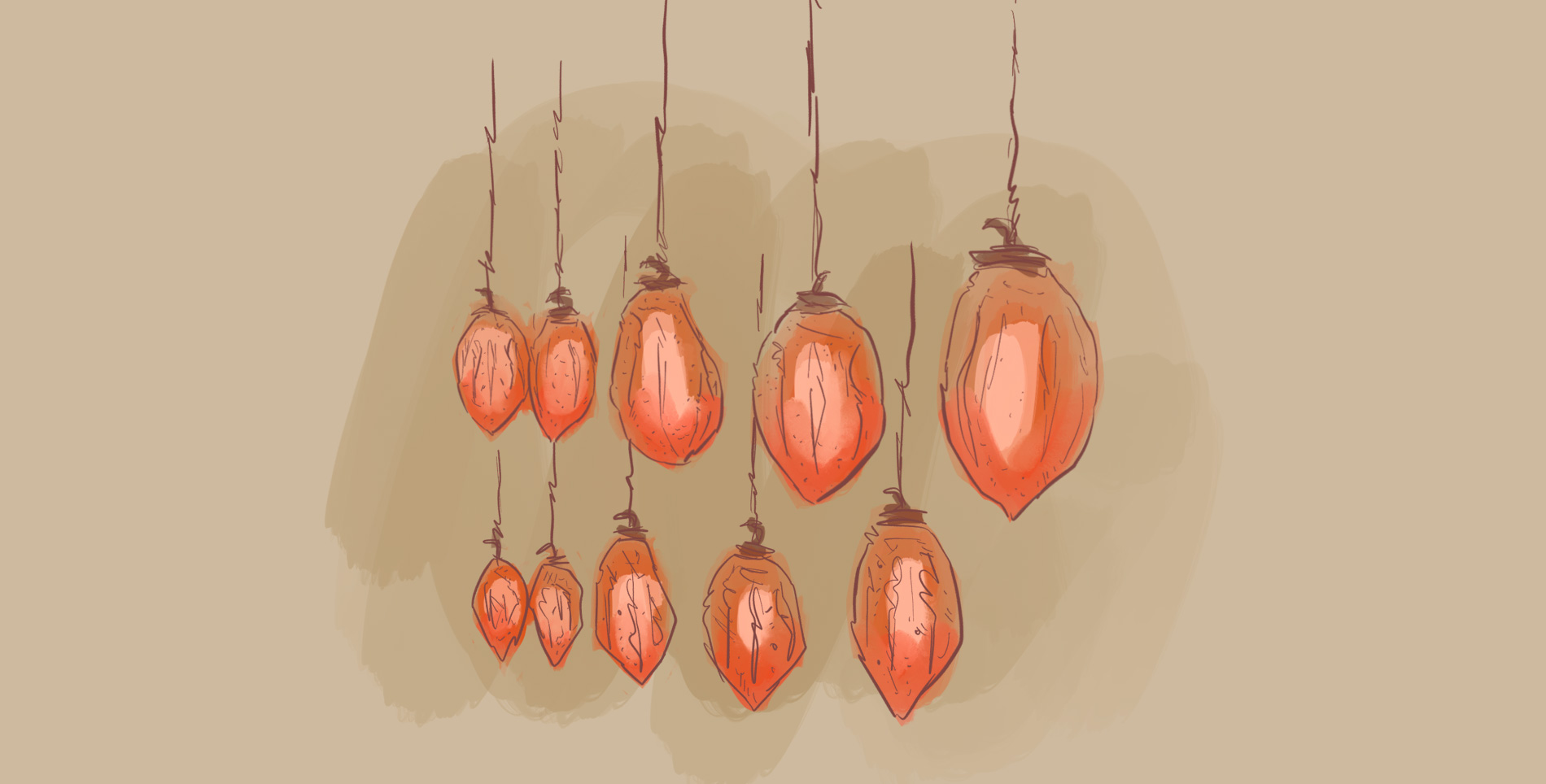

Our comments section is for members only.
Join today to gain exclusive access.